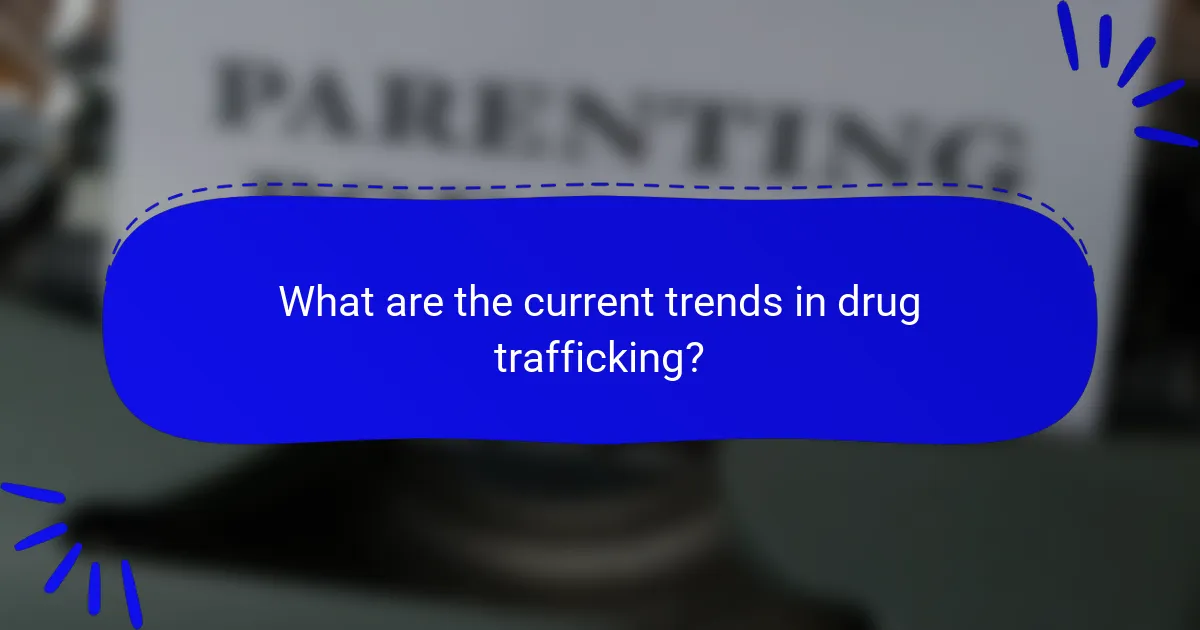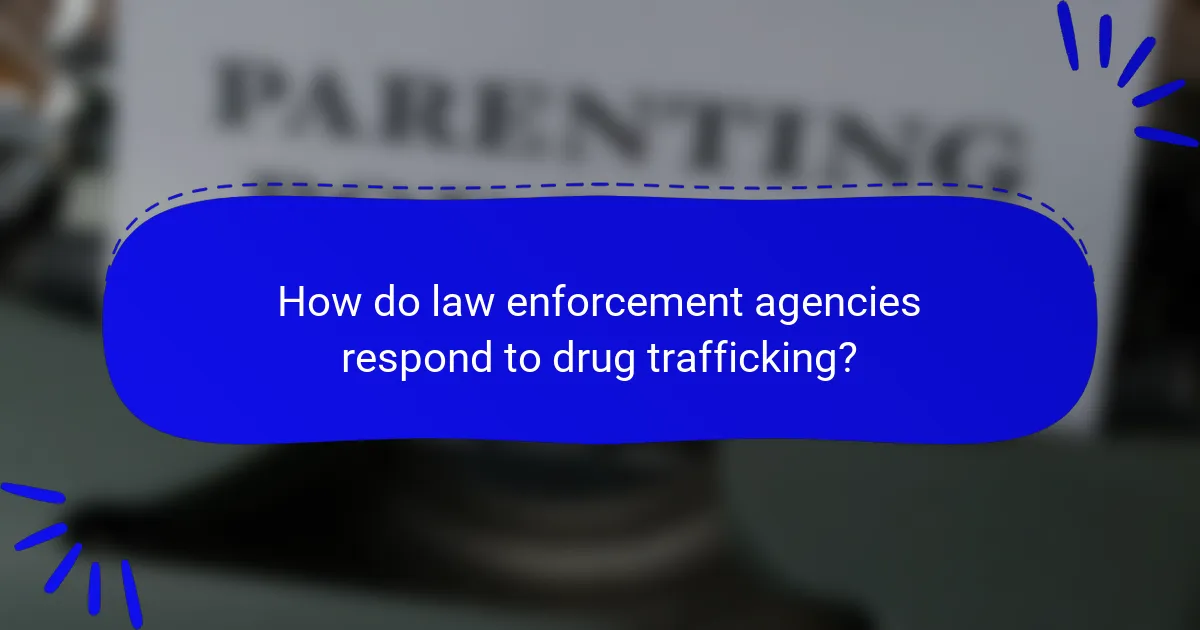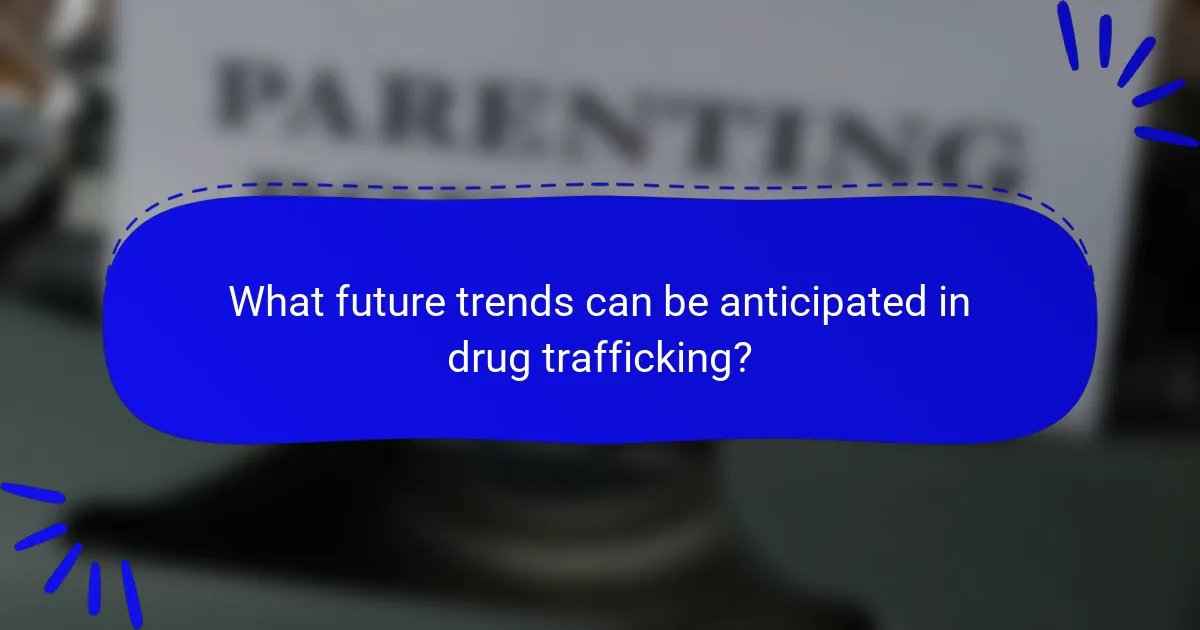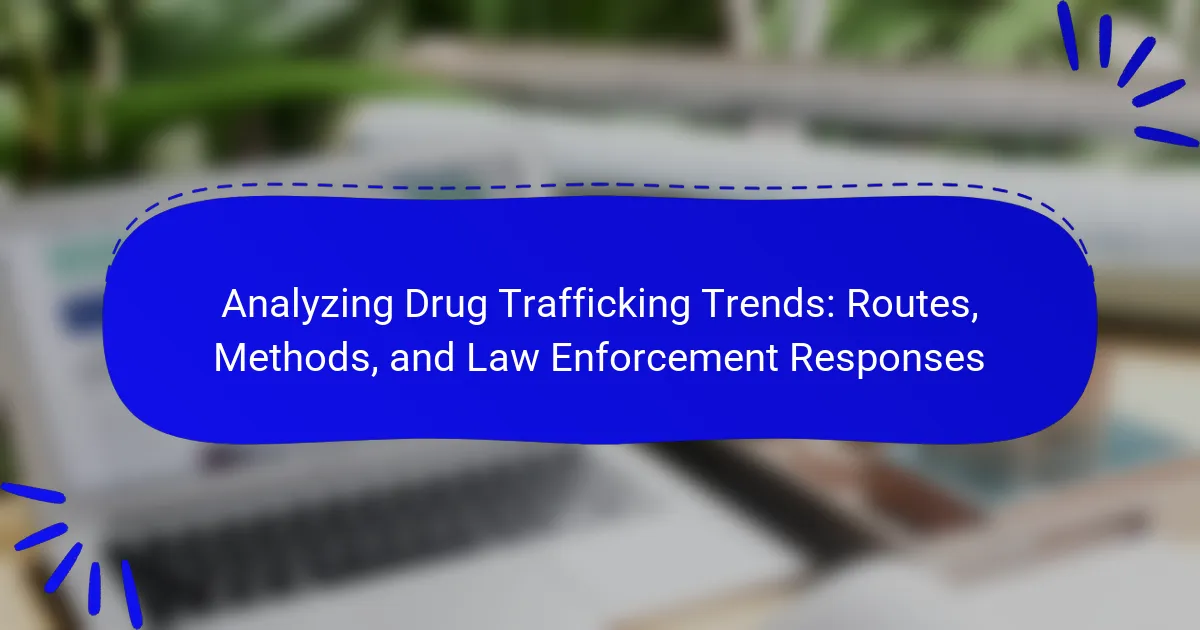
What are the current trends in drug trafficking?
Current trends in drug trafficking include increased use of digital platforms for distribution. Traffickers are leveraging the dark web to facilitate anonymous transactions. Synthetic drugs, particularly fentanyl, are becoming more prevalent in the market. This shift is due to their higher potency and lower production costs. Additionally, drug trafficking organizations are diversifying their routes. They are now utilizing more complex networks to evade law enforcement. The rise of transnational criminal organizations is also notable. These groups are collaborating across borders to enhance their operations. Data from the United Nations Office on Drugs and Crime supports these observations. Reports indicate a significant rise in synthetic drug seizures globally.
How do drug trafficking routes evolve over time?
Drug trafficking routes evolve over time due to various factors. Changes in law enforcement strategies impact route selection. Increased border security often forces traffickers to find alternative paths. Economic shifts can also influence the demand for specific drugs. Additionally, technological advancements enable traffickers to optimize their operations. Historical data shows that routes often shift in response to crackdowns in certain regions. For instance, after increased enforcement in Colombia, traffickers moved operations to Mexico. This adaptability helps sustain the drug trade despite ongoing efforts to combat it.
What factors influence the choice of drug trafficking routes?
The choice of drug trafficking routes is influenced by several factors. Geographic location plays a significant role. Proximity to production areas and demand markets affects route selection. Law enforcement presence impacts route viability. Increased surveillance or policing can deter traffickers from certain paths. Economic factors, such as transportation costs and potential profits, also drive decisions. Additionally, political stability in transit countries influences route safety. Traffickers often prefer areas with weak governance or corruption. Finally, historical routes and established networks can dictate current choices.
How do geographic and political changes affect these routes?
Geographic and political changes significantly affect drug trafficking routes. Changes in geography, such as natural disasters or terrain alterations, can disrupt established pathways. These disruptions may force traffickers to seek alternative routes, often leading to increased transportation costs. Political changes, such as shifts in government or law enforcement policies, can also impact trafficking dynamics. For instance, stricter border controls can hinder smuggling operations. Conversely, political instability may create opportunities for traffickers to exploit weakened enforcement. Historical examples include the rise of drug cartels in areas with corrupt governance, facilitating easier movement of illicit goods. Such factors collectively influence the adaptability and evolution of trafficking routes.
What methods are commonly used in drug trafficking?
Drug trafficking commonly employs methods such as smuggling, distribution networks, and money laundering. Smuggling involves transporting drugs across borders using concealed compartments in vehicles, shipping containers, or even human couriers. Distribution networks consist of organized groups that manage the sale and distribution of drugs in various regions. Money laundering is used to disguise the origins of drug money, often through complex financial transactions. According to the United Nations Office on Drugs and Crime, drug trafficking generates billions in revenue, making it a lucrative illegal industry.
What are the primary transportation methods for drug trafficking?
The primary transportation methods for drug trafficking include land, air, and sea routes. Land transportation often involves vehicles like cars, trucks, and motorcycles. Traffickers use these methods to move drugs across borders and within countries. Air transportation typically utilizes small planes and drones for quick delivery. Sea transportation involves shipping containers and submarines for large quantities of drugs. According to the United Nations Office on Drugs and Crime, these methods are frequently employed due to their effectiveness in evading law enforcement. Each method has unique advantages, making them popular choices among traffickers.
How do traffickers adapt their methods to evade law enforcement?
Traffickers adapt their methods to evade law enforcement by employing various strategies. They often change routes to avoid detection. This includes using less monitored pathways and remote locations. Traffickers may also utilize technology to communicate securely. Encrypted messaging apps help them coordinate activities without interception. Additionally, they frequently alter their transportation methods. This can involve switching from large vehicles to smaller, inconspicuous ones. Some traffickers use legitimate businesses as fronts for their operations. This strategy helps them blend in with lawful activities. They also engage in counter-surveillance to detect law enforcement presence. By staying informed about law enforcement tactics, traffickers can modify their operations. These adaptations make it challenging for authorities to combat trafficking effectively.
What are the implications of drug trafficking trends on society?
Drug trafficking trends significantly impact society by increasing crime rates and destabilizing communities. These trends lead to heightened violence as rival gangs compete for control over drug markets. According to the National Institute on Drug Abuse, drug-related deaths have surged, contributing to public health crises. Additionally, drug trafficking strains law enforcement resources, diverting attention from other crimes. Economic implications include lost productivity and increased healthcare costs associated with addiction. Overall, drug trafficking trends create a cycle of social and economic instability, affecting families and communities nationwide.
How does drug trafficking impact public health and safety?
Drug trafficking significantly impacts public health and safety by increasing substance abuse and related health issues. It leads to a rise in overdose deaths, with the CDC reporting over 100,000 drug overdose deaths in the U.S. in 2021. Communities affected by drug trafficking experience higher crime rates, leading to unsafe environments. Drug trafficking also strains healthcare systems, as resources are diverted to treat addiction and its consequences. Furthermore, it contributes to the spread of infectious diseases through unsafe drug use practices. The economic burden on society includes healthcare costs and lost productivity, amounting to billions annually. Overall, drug trafficking poses a serious threat to both individual and community well-being.
What economic effects does drug trafficking have on communities?
Drug trafficking negatively impacts communities by fostering economic instability. It often leads to increased crime rates, which can deter investment and business development. Local economies may suffer as resources are diverted to law enforcement and healthcare costs related to drug abuse. Additionally, drug trafficking can create a dependency on the illegal economy, undermining legitimate job opportunities. According to the National Institute on Drug Abuse, communities with high drug trafficking activity often experience reduced property values and increased unemployment rates. This creates a cycle of poverty and crime that is difficult to escape.

How do law enforcement agencies respond to drug trafficking?
Law enforcement agencies respond to drug trafficking through various strategies and operations. They conduct investigations to identify trafficking networks. Agencies collaborate with international counterparts to combat cross-border trafficking. They utilize intelligence sharing to track drug movements. Law enforcement employs undercover operations to infiltrate drug organizations. They also execute raids on suspected drug production and distribution sites. Agencies implement community outreach programs to educate the public about drug dangers. Statistics show that these efforts have led to significant drug seizures and arrests, disrupting trafficking operations. For instance, in 2020, U.S. law enforcement seized over 4,000 kilograms of illicit drugs.
What strategies are employed by law enforcement to combat drug trafficking?
Law enforcement employs various strategies to combat drug trafficking. These strategies include intelligence gathering, surveillance, and undercover operations. Intelligence gathering helps identify drug trafficking networks and key players. Surveillance allows law enforcement to monitor suspicious activities and movements. Undercover operations involve officers infiltrating drug organizations to gather evidence.
Additionally, law enforcement collaborates with international agencies to share information and resources. This collaboration enhances their ability to disrupt cross-border trafficking. Community outreach programs also play a role by encouraging public reporting of suspicious activities.
Data from the National Drug Control Strategy highlights the effectiveness of these strategies. In 2020, law enforcement seized over 5,000 kilograms of illegal drugs, demonstrating the impact of these efforts.
How effective are these strategies in different regions?
The effectiveness of strategies against drug trafficking varies significantly across different regions. In North America, comprehensive law enforcement efforts and community programs have led to a noticeable reduction in opioid-related deaths. For instance, the implementation of harm reduction strategies in cities like San Francisco has resulted in a 20% decrease in overdose deaths over two years. In contrast, regions in South America face challenges due to corruption and limited resources, hindering effective strategy implementation. Countries like Colombia have seen mixed results despite heavy investment in military and law enforcement operations. In Europe, a focus on drug prevention and treatment has shown effectiveness, with countries like Portugal reporting a 50% drop in drug-related deaths since decriminalization. Overall, regional effectiveness is influenced by local governance, socio-economic factors, and the specific drug threats faced.
What role does international cooperation play in law enforcement responses?
International cooperation is crucial in law enforcement responses to drug trafficking. It enables countries to share intelligence and resources effectively. Collaborative efforts enhance the ability to track and dismantle drug trafficking networks. For instance, operations like Operation Interception involve multiple nations working together. These joint efforts can lead to significant seizures of illegal drugs. According to the United Nations Office on Drugs and Crime, international collaboration has resulted in a 30% increase in drug seizures in recent years. Furthermore, extradition treaties facilitate the prosecution of traffickers across borders. Overall, international cooperation strengthens the global fight against drug trafficking.
What challenges do law enforcement agencies face in addressing drug trafficking?
Law enforcement agencies face significant challenges in addressing drug trafficking. One major challenge is the sophistication of trafficking networks. These networks often use advanced technology and methods to evade detection. Corruption within law enforcement and government can hinder efforts to combat trafficking. Additionally, limited resources and funding restrict the capabilities of agencies. Jurisdictional issues complicate coordination between local, state, and federal agencies. The transnational nature of drug trafficking makes it difficult to enforce laws across borders. Moreover, the demand for drugs continues to rise, fueling the market. Finally, public perception and stigma surrounding drug use can affect policy and funding decisions.
How do resource limitations affect enforcement efforts?
Resource limitations significantly hinder enforcement efforts. Insufficient funding restricts the number of personnel available for operations. This leads to fewer patrols and investigations. Limited technology reduces the effectiveness of surveillance and intelligence gathering. Consequently, law enforcement agencies struggle to keep up with evolving drug trafficking methods. For instance, a report by the National Institute on Drug Abuse highlights that budget cuts directly impact drug enforcement operations. The lack of resources can result in lower arrest rates and decreased deterrence against traffickers. Overall, resource constraints create a cycle of inefficiency in tackling drug-related crimes.
What obstacles do agencies encounter in gathering intelligence?
Agencies encounter several obstacles in gathering intelligence related to drug trafficking. Limited resources hinder their ability to collect and analyze data effectively. Additionally, the complexity of drug networks makes it challenging to track movements and operations. Inconsistent information from informants can lead to unreliable intelligence. Legal restrictions may limit surveillance and data collection methods. The rapid evolution of trafficking methods complicates intelligence efforts. Finally, inter-agency coordination issues can result in fragmented information sharing. These factors collectively impede effective intelligence gathering and analysis in combating drug trafficking.
How can law enforcement improve their responses to drug trafficking?
Law enforcement can improve their responses to drug trafficking by enhancing intelligence-sharing and collaboration. Effective communication between agencies leads to better operational strategies. Training officers in current drug trends and trafficking methods is essential. This knowledge allows for more targeted enforcement actions. Utilizing technology, such as data analytics and surveillance, aids in identifying trafficking networks. Statistics show that jurisdictions employing these technologies report higher seizure rates. Additionally, community engagement fosters public cooperation in reporting suspicious activities. Programs that educate the public about drug trafficking can create a more informed community. Overall, a multifaceted approach strengthens law enforcement’s capability to combat drug trafficking effectively.
What best practices can be implemented to enhance effectiveness?
Implementing best practices to enhance effectiveness in analyzing drug trafficking trends involves several strategic actions. First, law enforcement agencies should utilize data analytics to identify patterns and trends in drug trafficking. This approach enables timely and informed decision-making. Second, collaboration among local, national, and international agencies is crucial. Sharing intelligence can improve operational efficiency and response times. Third, employing advanced technology, such as drones and surveillance systems, can enhance monitoring capabilities. Fourth, continuous training for personnel in emerging drug trafficking methods is essential. This ensures that law enforcement remains adaptive and knowledgeable. Finally, community engagement can aid in gathering information and fostering trust. These practices collectively contribute to a more effective response to drug trafficking.
How can technology be utilized to combat drug trafficking more effectively?
Technology can be utilized to combat drug trafficking more effectively through advanced surveillance systems. Drones equipped with high-resolution cameras can monitor remote areas often used for trafficking. Artificial intelligence can analyze large data sets to identify trafficking patterns and hotspots. Blockchain technology can enhance the traceability of shipments, making it harder for traffickers to operate undetected. Mobile applications can facilitate real-time reporting of suspicious activities by the public. Additionally, biometric identification systems can improve border security and track individuals involved in trafficking. These technological advancements have been shown to increase the efficiency of law enforcement operations. For instance, the use of AI in predictive policing has led to a significant reduction in drug-related crimes in certain regions.

What future trends can be anticipated in drug trafficking?
Future trends in drug trafficking include increased use of technology, such as encrypted communication and cryptocurrency. Traffickers are likely to adopt advanced logistics and distribution methods. These methods may involve drones and automated delivery systems. Law enforcement will face challenges in tracking these evolving techniques. Additionally, the rise of synthetic drugs will continue to reshape the market. This shift can lead to more potent substances with higher risks. The ongoing globalization of supply chains will further complicate enforcement efforts. As a result, international cooperation will become essential in combating drug trafficking.
How might emerging technologies impact drug trafficking methods?
Emerging technologies could significantly alter drug trafficking methods. Innovations such as blockchain enable secure, anonymous transactions. This can facilitate illicit drug sales on the dark web. Drones are increasingly used for transporting drugs across borders, avoiding traditional checkpoints. Additionally, advanced data analytics help traffickers identify law enforcement patterns. Artificial intelligence can optimize routes for drug distribution. These technologies make detection more challenging for authorities. For instance, the use of encrypted communication apps allows traffickers to coordinate without interception. Overall, these advancements enhance operational efficiency for drug traffickers.
What potential developments in law enforcement could change the landscape?
Advancements in technology and data analytics could significantly change law enforcement. The integration of artificial intelligence can enhance predictive policing. AI can analyze crime patterns and allocate resources more effectively. Drones may provide aerial surveillance capabilities in hard-to-reach areas. Body-worn cameras can increase transparency and accountability among officers. The use of blockchain technology may improve evidence management and chain of custody. Enhanced collaboration between agencies through shared databases can lead to more efficient investigations. These developments suggest a shift towards more proactive and data-driven law enforcement strategies.
What role does public awareness play in combating drug trafficking?
Public awareness plays a crucial role in combating drug trafficking. It educates communities about the dangers and signs of drug abuse and trafficking. Increased awareness can lead to community vigilance and reporting suspicious activities. Studies show that informed communities are more likely to cooperate with law enforcement. For instance, the National Institute on Drug Abuse highlights community programs that reduce drug-related crime through public education. This proactive approach can disrupt trafficking networks by increasing the risk for traffickers. Public awareness campaigns can also reduce stigma around addiction, encouraging individuals to seek help. Overall, informed citizens contribute to a safer environment and support law enforcement efforts.
How can education and prevention strategies be improved?
Education and prevention strategies can be improved by integrating evidence-based practices. These practices should focus on community engagement and tailored messaging. Research indicates that programs involving parents and community leaders enhance effectiveness. Additionally, utilizing technology for interactive learning can reach broader audiences. Data from the National Institute on Drug Abuse shows that comprehensive programs reduce substance misuse by up to 50%. Regular training for educators on current trends in drug trafficking is essential. This ensures accurate information dissemination. Collaboration with local law enforcement can provide real-world context to educational content. Implementing these strategies can lead to significant improvements in prevention efforts.
What practical steps can communities take to address drug trafficking issues?
Communities can implement several practical steps to address drug trafficking issues. First, they can enhance local law enforcement collaboration. This includes forming partnerships with federal agencies like the DEA. Second, communities can establish neighborhood watch programs. These programs empower residents to report suspicious activities. Third, educational initiatives can raise awareness about the dangers of drug trafficking. Schools and community centers can host informational sessions. Fourth, communities can promote drug prevention programs. These programs help reduce demand by providing support and resources. Fifth, local governments can allocate funding for drug treatment services. Access to treatment can aid individuals struggling with addiction. Finally, community engagement is crucial. Involving residents in decision-making fosters a collective approach to combat trafficking. These steps have been shown to effectively reduce drug-related crime in various regions.
The main entity of the article is drug trafficking, which encompasses the routes, methods, and law enforcement responses associated with the distribution of illegal drugs. The article analyzes current trends in drug trafficking, highlighting the rise of digital platforms, the prevalence of synthetic drugs, and the evolution of trafficking routes influenced by law enforcement strategies and geographic changes. It discusses the methods employed by traffickers, including smuggling and money laundering, as well as the implications of drug trafficking on public health and community safety. Furthermore, the article examines law enforcement strategies, challenges faced in combating drug trafficking, and the role of international cooperation in addressing this complex issue.
